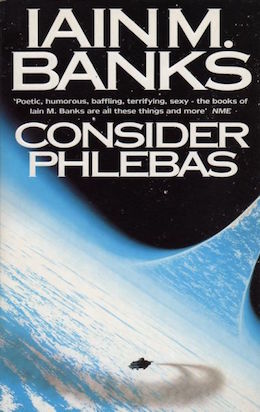Welcome to the Culture Reread! Today in chapters 3 and 4 of Consider Phlebas, Horza gets some new friends—well, one, anyway—and in our first “State of Play” break, we drop in on the Culture for a look at the war from their side.
As I write, I am currently reeling a little from the news that Amazon has decided to make Consider Phlebas into their own Altered Carbon, or something like that. Absent a showrunner or cast, I can’t really bring myself to be optimistic or pessimistic at this point, but I can think of a few ways that Amazon could really screw this up. On that subject Damien Walter has a post at Medium that I don’t disagree with. We’ll see.
Chapter 3: Clear Air Turbulence
When last we left Horza, he was floating in space waiting for an Idiran rescue. He gets scooped up by an effector beam that knocks him unconscious, and comes round on the deck of a ship, rousing himself properly just in time to protest being thrown out the airlock. His accidental rescuers are a group of space pirates led by a man called Kraiklyn. He informs Horza that the ship is full, and if he wants to avoid getting kicked back off the ship—this time without his very nice spacesuit, which Kraiklyn has taken for himself—he’s going to need to create a vacancy. By fighting one of the crew to the death.
Given the choice between that and being airlocked, Horza takes the fight. The odds are not great. His opponent, Zallin, is a massive young man, and Horza is still stuck in the shape of a Gerontocrat—apparently elderly and withered, and out of shape—and his Changer’s poison teeth, which might have provided an advantage, were pulled out on Sorpen. Zallin very nearly wins, but in a bit of blind luck, he slips right before delivering the coup de grace to Horza’s head, allowing the Changer to get the upper hand.
Horza would rather not kill Zallin. But Kraiklyn casually aims a laser pistol at Horza’s head and informs him, “I’ve no place on this ship for somebody who doesn’t have the taste for a little murder now and then.” Faced with this choice that isn’t really a choice at all, Horza snaps Zallin’s neck. With that reluctant killing, Horza joins Kraiklyn’s Free Company.
By now it should be fairly obvious that Horza, shape-shifting spy though he is, is not a particularly ass-kicking action hero. Despite his best efforts, he doesn’t so much make his own way as get kicked along by events and chance like a football. And now he’s stuck with a not-so-plucky mixed bag of misfit freebooters, on what is about to become an extremely unpleasant trip.
Chapter 4: Temple of Light
Yalson—a woman who quickly becomes the closest thing Horza has to a friend on board the CAT—brings him up to speed on where they’re headed next. First stop is “a just-about-level-three planet,” where Kraiklyn has promised an “easy in, easy out” raid on a temple—drop in, kill the monks and priests, grab the treasure, and go. The next stop will be Vavatch, a Culture Orbital in the war zone that—to Horza’s considerable shock—the Culture has decided to destroy rather than allow to fall into Idiran hands. Equally astonishing is that they plan to evacuate it, an effort roughly on the scale of attempting to evacuate a planet. Kraiklyn apparently reckons that supplies, including a new bow laser for the CAT, will be selling for cheap there.
Horza gets to know Kraiklyn a little better, and the man who demanded an entirely gratuitous fight to the death only becomes less pleasant. He has an “enhanced hemispherical task-division” in his brain—one half sleeps a third of the time, then the other, and then both halves are awake, meaning that he’s never really asleep. Horza deflects his attempts to dig into his past, rolls his eyes at Kraiklyn’s excessive interest in the rumored sexual abilities and drug glands of the Culture (which is apparently something a lot of piggish non-Culture humanoid males tend to fixate on), and comes out of the conversation with a plan: to use his Changer abilities to take out and replace Kraiklyn.
But first: the Temple of Light. Which is a disaster. Where Kraiklyn had led his Company to expect a group of easily-defeated monks, they find that their targets are not only well-armed, but that the temple itself is a weapon: the interior is built entirely of crystal, which creates a diabolical form of friendly fire by reflecting back laser shots onto the attackers. Seven of the crew end up dead or missing, either from the unexpected resistance of the monks or from the reflected shots—and in one case, from suicide, when one of the CAT’s women finds her partner has been killed.
The remainder of Kraiklyn’s Free Company shambles back to the Clear Air Turbulence, where a sickened and tired Horza and Yalson find what comfort they can in one another. As the ship heads off to Vavatch, they learn a little more about why the Temple wasn’t easy pickings. Banks may be hammering at his themes just a little too hard here, but there’s still irony to be appreciated: “Two nation states on the world of Marjoin were at war, and the temple was near the frontier between the two countries, constantly ready for attack. One of the states was vaguely socialist; the other was religiously inspired, the priests in the Temple of Light representing one sect of that militant faith. The war was partly caused by the greater, galactic conflict taking place around it, as well as being a tiny and approximate image of it. It was that reflection, Horza realized, which had killed the members of the Company, as much as any bounced laser flash.”
State of Play 1
I’ve been thinking a lot about Banks’s use of a line from The Waste Land as the title of this book, and while I’m going to wait on any conclusions about it until I finish rereading the novel, I did think of these lines as I started digging into this chapter:
Madame Sosostris, famous clairvoyante,
Had a bad cold, nevertheless
Is known to be the wisest woman in Europe,
With a wicked pack of cards.
The Culture is “a self-consciously rational society,” and its reliance on artificial intelligence is grounded in that self-perception and the theory that machines will be the most capable and efficient in achieving that level of rationality. As such, they don’t have clairvoyants, but thanks to the sheer power of statistics and biology, they do have about thirty or forty people out of its eighteen trillion “well nourished, extensively educated, and mentally alert” citizens with the “unusual ability to forecast and assess on a par with a well-informed Mind.” Fal ’Ngeestra is one of them. Currently, to her chagrin, she’s far from the action on a Culture Orbital, recovering from a climbing accident that shattered her leg. Her chief company is an old drone—an AI of roughly human intelligence—named Jase, who has a rather sweet secret crush on her. (Yes, it seems a little weird at first—but arguably there’s no reason why one sentient, emotion-capable being couldn’t develop tender feelings for another, regardless of biology.) Fal is treated like an oracle, constantly plied with problems and ideas that require her unique talents. She also exists under near-constant observation, except—at her insistence—when she goes mountain-climbing. An uncharitable observer might go so far as to call it surveillance. Indeed, Fal wonders if, in the accident that broke her leg, the Minds were actually watching her the whole time and then let her lie there, injured, “just to convince her that they were doing no such thing, and to see the effect it had on her, as long as she wasn’t in any real danger of dying. She knew, after all, the way their Minds worked. It was the sort of thing she would consider doing, if she was in charge.”
The latest problem brought to her is, of course, that of the Mind currently hiding out on Schar’s World. Here we learn a little more about both Minds and the planet. As Jase explains, any given Mind exists in physical space as a large, dense, fantastically heavy ellipsoid, but its “thinking parts” exist in hyperspace, thanks to an “internal warping unit.” It’s this unit that the Mind used to drop into hyperspace and warp under the surface of Schar’s World, a tricky and unprecedented maneuver. As for Schar’s World, all humanoid life there was destroyed eleven thousand years ago after a catastrophic biological weapons war. It’s been preserved by the Dra’Azon, “a pure-energy superspecies long retired from the normal, matter-based life of the galaxy,” who make a practice of cordoning off planets like this as “a fitting monument to death and futility.” It’s noteworthy that even the Culture, advanced though they are, find the Dra’Azon almost completely inscrutable and are very unwilling to risk antagonizing them—there are limits to their abilities and understanding, limits that will be increasingly clear as the novels progress.
The Culture is aware of the Idiran plan to send Horza after the Mind, but what Fal really wants to know is: how much should the Culture really worry? What’s the difference if the Idirans get the Mind? Jase informs her that the Minds, assuming a Culture victory, suggest that the war could be lengthened by somewhere between three and seven months if Horza succeeds. So what should the Culture do? Fal asks to be given time to contemplate the problem. She rules out directly attacking or destroying Schar’s World, due to the likely cost of upsetting the Dra’Azon. She needs more information before she can decide.
Three to seven months. Is it worth it? It’s enough to make Horza’s misadventures seem trivial against the backdrop of a war that’s already consumed four years, billions of lives, and planets all over the galaxy. But of course, for the people wrapped up in it—for Horza—it’s anything but trivial. How, one begins to wonder, is Kraiklyn’s casual handling of the lives of his crew any different than the willingness of either side in the war to kill or destroy, save in scale?
The Minds don’t have to consult with someone like Fal ’Ngeestra. An observer could interpret their willingness to do so as simply giving her something to do, the way you might give your dog a chew toy. Horza, with his antipathy towards artificial intelligence, might see it that way. Or perhaps they do so because they recognize something unique in the human perspective—that her point of view may offer insights that no machine could arrive at.
Next up: we arrive on Vavatch, imminently doomed home of vast cruise ships and site of a worrying-sounding game called “Damage.” And Horza meets a spectacularly appalling cult that is one of the reasons why I sometimes suggest you don’t read Banks while you’re eating.
Karin Kross lives and writes in Austin, TX. She can be found elsewhere online at hangingfire.net, on Tumblr, and on Twitter.










